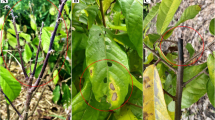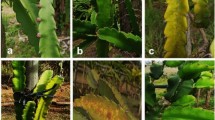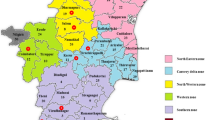Abstract
Based on filamentous particles, aphid transmission, and symptoms of distorted, size-reduced, woody fruits, the major potyvirus associated with passionfruit woodiness disease (PWD) in Taiwan has been regarded as Passionfruit woodiness virus (PWV) for decades. In this study, the genomes of four potyvirus isolates, originally collected from orchards with PWD in Taiwan and re-designated as Poty-TW, Poty-0920-6, Poty-dpd and Poty-pt, were sequenced for molecular characterization. Our results revealed that the CP genes of Poty-TW and Poty-0920-6 share nucleotide (nt) identities/amino acid (aa) identities of 97.7/95.9 and 98.5/97.2%, respectively, with that of East Asian passiflora virus (EAPV) isolate AO of Japan, and the CP genes of Poty-dpd and Poty-pt share nt/aa identities of 95.3/96.2 and 94.9/97.6% respectively, with that of EAPV isolate IB of Japan. The genomic sequences of PWD-associate viruses in Taiwan also share high degrees of homology with that of EAPV-AO (TW and 0920-6 isolates > 98%) and EAPV-IB (dpd and pt isolates > 88%). However, the CP genes of four PWD-associated viruses from Taiwan share only 67.6–69.4% nt identities with that of PWV Australia MU isolate, does not satisfy the ICTV criteria (> 76%) to be regarded as a strain of PWV. A field survey with 175 samples from different areas of Taiwan demonstrated that the PWD-associated potyvirus is mainly caused by EAPV. Hence, our results indicate that the major potyvirus causing PWD in Taiwan should be reclassified as EAPV.





Similar content being viewed by others
References
Abdullah N, Ismail I, Pillai V, Abdullah R, Sharifudin AS (2009) Nucleotide sequence of the coat protein gene of the Malaysian passiflora virus and its 3′ non-coding region. Am J Appl Sci 6:1633–1636
Adams MJ, Antoniw JF, Fauquet CM (2005) Molecular criteria for genus and species discrimination within the family Potyviridae. Arch Virol 150:459–479
Adams MJ, Zerbini FM, French R, Rabenstein F, Stenger DC, Valkonen JPT (2012) Family potyviridae. In: King AMQ, Adams MJ, Carstens EB, Lefkowich EJ (eds) Virus taxonomy: Ninth report of the international committee on taxonomy of viruses. Elsevier Academic, San Diego, pp 1069–1089
Anindya R, Savithri HS (2003) Surface-exposed amino- and carboxy-terminal residues are crucial for the initiation of assembly in Pepper vein banding virus: a flexuous rod-shaped virus. Virology 316:325–336
Bernacci LC, Soares-Scott MD, Junqueira NTV, Passos IRDS, Meletti LMM (2008) Passiflora edulis Sims: the correct taxonomic way to cite the yellow passion fruit (and of others colors). Rev Bras Frutic 30:566–576
Brand RJ, Wechmar MB von (1993) Characterization of two viruses implicated in the woodiness disease complex of South African passionfruit: Cucumber mosaic virus and a new potyvirus. J South Afr Soc Hortic Sci 3:28–33
Chang CA (1992) Characterization and comparison of passionfruit mottle virus, a newly recognized potyvirus, with Passionfruit woodiness virus. Phytopathology 82:1358–1363
Chang CA, Lin HH (1989) Passionfruit crinkle virus, a new potyvirus isolated from passionfruit in Taiwan. Plant Prot Bull 31:409–410
Chang CA, Wang HC, Chen YL, Chou TY (1981) The investigation and identification of virus disease of passionfruit in Taiwan. Plant Prot Bull 23:267
Chang CA, Chen CC, Deng TC, Zettler FW (1996) Characterization of passionfruit crinkle potyvirus—a newly found virus infecting passionfruit. Plant Prot Bull 38:339–354
Cheng YH, Deng TC, Chen CC, Chiang CH, Chang CA (2014) First report of Euphorbia leaf curl virus and Papaya leaf curl Guangdong virus on passion fruit in Taiwan. Plant Dis 98:1746
Colinet D, Kummert J (1993) Identification of a Sweet potato feathery mottle virus isolate from China (SPFMV-CH) by the polymerase chain reaction with degenerate primers. J Virol Methods 45:149–159
Coutts BA, Kehoe MA, Webster CG, Wylie SJ, Jones RAC (2011) Indigenous and introduced potyviruses of legumes and Passiflora spp. from Australia: biological properties and comparison of coat protein nucleotide sequences. Arch Virol 156:1757–1774
Dassanayake EM, Hicks RGT (1992) Sri Lankan passionfruit mottle virus, a potyvirus infecting golden passionfruit in Sri Lanka. Ann Appl Biol 120:459–469
De Wijs JJ (1974) A virus causing ringspot of Passiflora edulis in the Ivory Coast. Ann Appl Biol 77:33–40
Fukumoto T, Nakamura M, Rikitake M, Iwai H (2012) Molecular characterization and specific detection of two genetically distinguishable strains of East Asian passiflora virus (EAPV) and their distribution in southern Japan. Virus Genes 44:141–148
Gibbs A, Ohshima K (2010) Potyviruses and the digital revolution. Annu Rev Phytopathol 48:205–223
Gibbs AJ, Trueman JWH, Gibbs MJ (2008) The bean common mosaic virus lineage of potyviruses: where did it arise and when? Arch Virol 153:2177–2188
Iwai H, Terahara R, Yamashita Y, Ueda S, Nakamura M (2006a) Complete nucleotide sequence of the genomic RNA of an Amami-O-Shima strain of East Asian passiflora potyvirus. Arch Virol 151:1457–1460
Iwai H, Yamashita Y, Nishi N, Nakamura M (2006b) The potyvirus associated with the dappled fruit of Passiflora edulis in Kagoshima Prefecture, Japan is the third strain of the proposed new species East Asian passiflora virus (EAPV) phylogenetically distinguished from strains of Passion fruit woodiness virus. Arch Virol 151:811–818
Jan FJ, Yeh SD (1995) Purification, in-situ localization, and comparative serological properties of passionfruit woodiness virus-encoded amorphous inclusion protein and 2 other virus proteins. Phytopathology 85:64–71
Kitajima EW, Rezende JAM, Rodrigues JCV, Chiavegato LG, Piza Júnior CT, Morozini W (1997) Green spot of passion fruit, a possible viral disease associated with infestation by the mite Brevipalpus phoenicis. Fitopatol Bras 22:555–559
Larkin MA, Blackshields G, Brown NP, Chenna R, McGettigan PA, McWilliam H, Valentin F, Wallace IM, Wilm A, Lopez R, Thompson JD, Gibson TJ, Higgins DG (2007) Clustal W and clustal X version 2.0. Bioinformatics 23:2947–2948
Lin NS, Chen YK, Hsu YH (1989) Immunological detection of Passionfruit woodiness virus. Bot Bull Acad Sin 30:31–37
Lin SS, Wu HW, Jan FJ, Hou RF, Yeh SD (2007) Modifications of the helper component-protease of Zucchini yellow mosaic virus for generation of attenuated mutants for cross protection against severe infection. Phytopathology 97:287–296
McKnight T (1953) The woodiness virus of the passion vine. Qd J Agric Sci 10:4–35
Nascimento AVS, Santana EN, Braz ASK, Alfenas PF, Pio-Ribeiro G, Andrade GP, de Carvalho MG, Zerbini FM (2006) Cowpea aphid-borne mosaic virus (CABMV) is widespread in passionfruit in Brazil and causes passionfruit woodiness disease. Arch Virol 151:1797–1809
Nattrass RM (1944) The transmission of the virus of the ‘woodiness’ disease of passion fruit (Passiflora edulis) by single leaf grafts. Ann Appl Biol 31:310–311
Ochwo-Ssemakula M, Sengooba T, Hakiza JJ, Adipala E, Edema R, Redinbaugh MG, Aritua V, Winter S (2012) Characterization and distribution of a potyvirus associated with passion fruit woodiness disease in Uganda. Plant Dis 96:659–665
Pares RD, Martin AB, Fitzell RD (1985) Virus-induced tip necrosis of passionfruit (Passiflora edulis Sims). Aus Plant Pathol 14:76–78
Parrella G, Castellano MA (2002) Passiflora chlorotic spot a disease caused by a strain of Bean yellow mosaic virus in Passiflora coerulea in Italy. J Plant Pathol 84:139
Polston JE, Londono MA, Cohen AL, Padilla-Rodriguez M, Rosario K, Breitbart M (2017) Genome sequence of Euphorbia mosaic virus from passionfruit and Euphorbia heterophylla in Florida. Genome Announc 5:e01714–e01716
Shukla DD, Ward CW (1989) Structure of potyvirus coat proteins and its application in the taxonomy of the potyvirus group. Adv Virus Res 36:273–314
Simon-Buela L, Guo HS, Garcia JA (1997) Long sequences in the 5′ noncoding region of Plum pox virus are not necessary for viral infectivity but contribute to viral competitiveness and pathogenesis. Virology 233:157–162
Singh AB (1971) Transmission of papaya leaf reduction virus by Myzus persicae. Plant Dis 55:526–529
Syller J (2012) Facilitative and antagonistic interactions between plant viruses in mixed infection. Mol Plant Pathol 13:204–216
Tamura K, Stecher G, Peterson D, Filipski A, Kumar S (2013) MEGA6: Molecular evolutionary genetics analysis version 6.0. Mol Biol Evol 30:2725–2729
Taylor RH, Greber RS (1973) Passion fruit woodiness virus. CMI/AAB. Description of plant viruses 122. Commonwealth Mycological Institute/Association of Applied Biologists, Kew
Trevisan F, Mendes BMJ, Maciel SC, Vieira MLC, Meletti LMM, Rezende JAM (2006) Resistance to Passionfruit woodiness virus in transgenic passionflower expressing the virus coat protein gene. Plant Dis 90:1026–1030
USAID-ACCESO (2014) The US market for fresh passion fruit. U. S. Agency International Development Market Brief 16. US AID, Washington, D.C., USA. http://pdf.usaid.gov/pdf_docs/PA00KP21.pdf. Accessed 6 July 2017
Vaca-Vaca JC, Carrasco-Lozano EC, López-López K (2017) Molecular identification of a new begomovirus infecting yellow passion fruit (Passiflora edulis) in Colombia. Arch Virol 162:573–576
Wang A, Krishnaswamy S (2012) Eukaryotic translation initiation factor 4E-mediated recessive resistance to plant viruses and its utility in crop improvement. Mol Plant Pathol 13:795–803
Wylie SJ, Jones MGK (2011) The complete genome sequence of a Passionfruit woodiness virus isolate from Australia determined using deep sequencing, and its relationship to other potyviruses. Arch Virol 156:479–482
Yeh SD, Chu FH (1996) Production and evaluation of transgenic tobacco plants expressing the coat protein gene of passionfruit woodiness virus. Bot Bull Acad Sin 37:181–190
Acknowledgements
This study was partially supported by Taiwan and National Chung Hsing University–University of California Davis (NCHU-UCD) Plant and Food Biotechnology programs (Project no. NSC104-2911-I-005-301), and the Ministry of Science and Technology (MOST), Taiwan (Project no. 104-2313-B-005-024-MY3).
Author information
Authors and Affiliations
Corresponding author
Rights and permissions
About this article
Cite this article
Chong, YH., Cheng, YH., Cheng, HW. et al. The virus causing passionfruit woodiness disease in Taiwan is reclassified as East Asian passiflora virus. J Gen Plant Pathol 84, 208–220 (2018). https://doi.org/10.1007/s10327-018-0777-4
Received:
Accepted:
Published:
Issue Date:
DOI: https://doi.org/10.1007/s10327-018-0777-4




